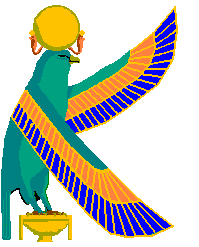 |
KHUFU 's LAST WILLBy Jean-François DESCHAMPS |
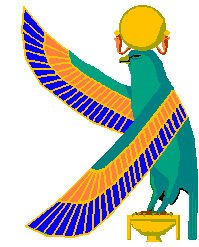 |
 |
KHUFU 's LAST WILLBy Jean-François DESCHAMPS |
 |
The aim of this article is to demonstrate that the Great Pyramid of Giza contains a message sent through time, by the builders of the last remaining Wonder of the World. The known structures of the pyramid are in fact a puzzle designed to reveal secret structures, mainly the hidden entrance to the Great Pyramid. There have been rumours of hidden structures inside the pyramid and underneath the Sphinx for a long time, but I now have the proof that at least one chamber remains undiscovered inside Khufu’s pyramid. I will demonstrate in the following lines that we could get access to these secret structures without destructive means for the pyramid and enter a chamber that has remained sealed for millennia.
![]() A message sent in a universal code.
A message sent in a universal code.
The message contained in the pyramid was not written in hieroglyphs or in any proper human language. It is conveyed through geometry, a language that any intelligent being can directly understand and decipher. The constituting elements of this geometric message are chambers, passages and shafts particularly the narrow meridian shafts of the King and Queen’s chambers (features that are totally unique in pyramid building).
![]() The shafts speak.
The shafts speak.
What I discovered last summer by studying the design of these shafts should have been discovered more than a century ago, when the hidden shafts of the Queen’s chamber were revealed by Waynman Dixon. Unfortunately at that time, Egyptologists did not ask the right questions. Instead, they stuck to the opinion that these shafts were made for ventilation purposes. Nowadays, Egyptologists tend to agree on a more reasonable explanation: that the shafts were designed to allow the dead Pharaoh’s soul to ascend to the heavens. I had this last theory in mind when I asked the right question.
I wondered why the shafts were not aligned with the sarcophagus, so that a direct link could be established between it and the targeted region of the sky. Instead of that, the shafts run several cubits horizontally before reaching the chamber. I then realised that both shafts, without their horizontal sections, would join at a point exactly in the central axis of the chamber, although approximately five cubits below the level of the King’s chamber (see fig.1). The same thing appeared in the case of the Queen’s chamber, so that I understood it might be a general pattern.
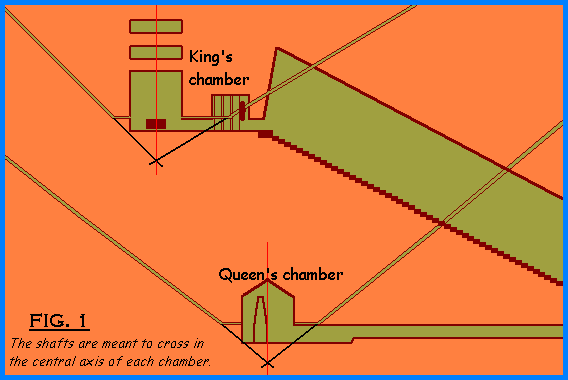
![]() The missing shaft.
The missing shaft.
Of the three chambers inside the pyramid, only two seem to possess shafts. The subterranean chamber is apparently devoid of similar structures. However, it possesses some strange features, among which is that low passage running South and leading to a blank wall. The idea came to me that it could stand for the horizontal section of a southern shaft. If we take the descending corridor as a northern shaft for the subterranean chamber and look where it crosses the central axis of the chamber, we can obtain a point a little below the pit. Now, thanks to that point and the southern horizontal passage, we can deduce a "virtual" southern shaft. The angle of that shaft is 14° 40’ (see fig.2).
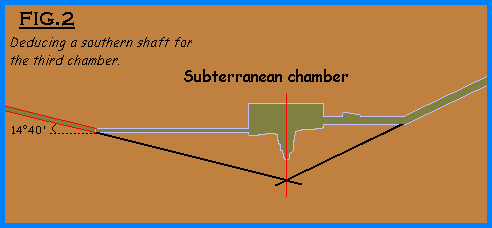
I had found a possible third pair of shafts, with the northern one being included in the descending corridor (26.5°) and the southern one being a virtual line of 14° 40’. But what was it meant to be? What was the function of all this?
I grew aware that all this system of shafts was designed as some kind of puzzle.
![]() Balancing the shafts.
Balancing the shafts.
I was then confronted with a little problem of balance. In the case of the two upper chambers, the shafts reach the outside of the pyramid more or less at the same height. But it’s not the case for the subterranean chamber’s shafts: the inclination they form to the horizontal plane is 7° 11’ (which is nearly half the angle of the southern shaft). And actually it is yet another confirmation of this virtual southern shaft, because it is approximately the same angle as the one we find inside the subterranean chamber between the two passages (see fig.3). It can thus be concluded that this angle was deliberately chosen. In order to readjust all this to the horizontal, a correction of some 7° 20’ must be applied on each side, so that the angles should be:
19° 11’ for the northern shaft.
22° for the southern shaft.
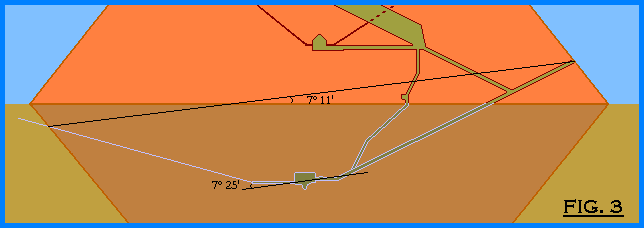
![]() The most ancient puzzle in the world.
The most ancient puzzle in the world.
By considering the three pairs of shafts in order, we can observe a progression, from the King’s chamber to the subterranean chamber:
a) In the King’s chamber, the shafts are completely apparent both inside the chamber and outside the pyramid.
b) In the Queen’s chamber, they exist but are hidden from view, being blocked on both ends.
c) In the subterranean chamber, they simply don’t exist except for a very small portion (the southern low passage).
This is a progression from something that is perfectly obvious to something that can only be deduced.
Now, since Rudolf Gantenbrink explored the shafts with his robot Upuaut II back in 1993, we know that there is a strange tiny portcullis door at the end of the southern shaft of the Queen’s chamber. The general opinion about that extraordinary discovery is that there should be some kind of secret and sacred chamber beyond that door. However, I would rather tend to think that there is nothing but silent stone. Many people do not seem to realise the ancient Egyptians could not foresee that one day, man would use small robots to go where he himself cannot. So that actually, we should consider that door from the outside of the pyramid and not from inside the shaft. In fact, just as the shafts in the King’s chamber were an indication that there could be similar shafts in the Queen’s chamber, we must see this small replica of a portcullis door as an indication that there could be a real door (or entrance) somewhere along the subterranean chamber’s "virtual shaft".
In order to know the exact position of that door, we must look for a point similar to that of the Gantenbrink door along the 22° southern shaft, according to the proportions of the pyramid. This point is situated 10.2 cubits below the surface and 66.6 cubits from the South end of the pyramid (see fig.4). Furthermore, that point also lies on the 7° 11' line mentioned above, which seems to be a confirmation of the obtained point.There could be some structure there and very probably a second, unknown entrance to the pyramid... |
 |
![]() The astronomical hypothesis.
The astronomical hypothesis.
In the 1980s Robert Bauval found a correlation between the pattern of the three stars in the belt of Orion and the ground plan of Giza and he explained how the pyramids could be linked to the stars in his book "The Orion Mystery" (I must say that it’s thanks to this book that I got very interested in the Great Pyramid). He also made popular the hypothesis that the shafts could have targeted stars at the time the pyramid was built (that is to say circa 2500 BC). According to that hypothesis the northern shafts were aimed at Alpha Draconis and Beta Ursa Minor and the southern shafts at Sirius and Zeta Orionis.
However, the shafts are symmetrical in relation to the apex of the pyramid. This fact in itself excludes the possibility of a connection with stars on both sides. Nevertheless, there still could be an astronomical relationship on one side with the other side balancing the "star shafts". Interestingly, for the epoch of 2500 BC, the targeting seems to be more accurate on the southern side than on the northern side. And as a matter of fact, if we look for a star aimed by the 22° "subterranean" southern shaft at that epoch, we find Rigel Kentaurus better known as Alpha Centauri. However, if Orion was associated with Osiris and Sirius with Isis, which deity could have been associated with Alpha Centauri or the constellation Centaurus?
In the Zodiac of Denderah, this constellation is represented as a lion associated with the symbol for water. And in the Zodiac of Esna, it is depicted as a sphinx!
Of course, only further evidence will tell whether this hypothesis is right or wrong. But I think I have made clear the strong possibility of hidden structures as well as, and perhaps it is the most important, the intentional aspect of all this. For what is the most extraordinary is the fact that Khufu’s pyramid was conceived in such a way that people could decipher that message and gain access to the secret structures. It is easily conceivable that the ancient Egyptians wanted their dead Pharaoh to rest in peace, but one can wonder why they should have wanted to make sure he would be found some day. Could it be that the Great Pyramid also contains the as yet undiscovered Sacred Books of Khufu?
Anyway, the one and only solution in order to know the truth is to open the door and get access to these secret structures. No doubt that it will give the answer to other enigmas and throw a light on the Egyptian society of the fourth dynasty. The only way to reach the secret entrance is by digging a tunnel. This tunnel would be 77 cubit long, starting at the foot of the pyramid’s south side, with an angle of 8.5° (see fig.9). I now hope to convince egyptologists and the Egyptian authorities of the necessity to carry out new investigations. Preliminary work could be done by means of remote sensing systems and, in any case, the excavation would not affect the pyramid itself. Without any major delays, the world of the year 2000 will give hand to the most ancient past of civilisation.
Thus Khufu’s last will shall be fulfilled.
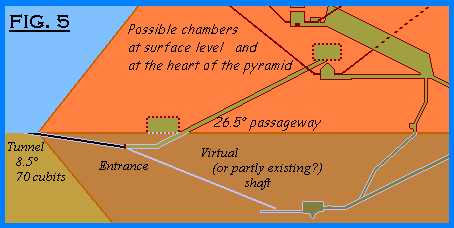
Copyright © April 1999 Jean-François Deschamps![]()
![]()